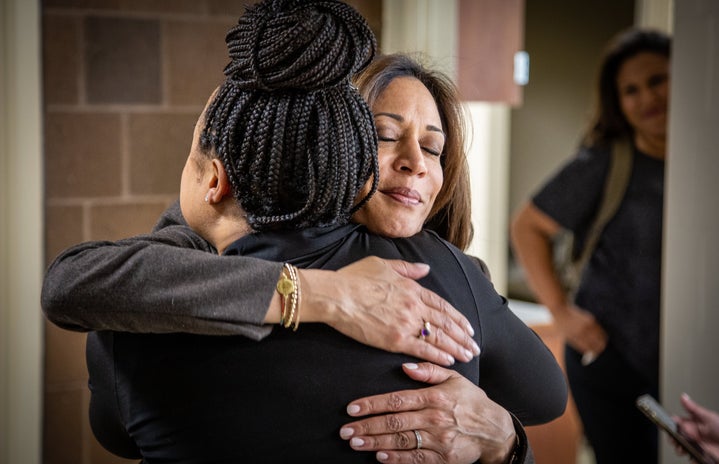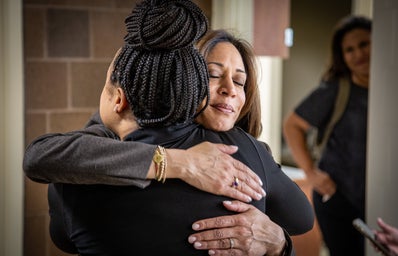A right-wing extremist, anti-establishment pioneer, ‘businessman’ and raging misogynist versus a woman. This was America’s 2024 election boiled down to its simplest form, and America chose the former.
Of course, we know Kamala Harris’ position is defined by far more than her gender. Serving as attorney general to California (2011-2017), standing in the senate (2017-2021) and acting as Vice President to Joe Biden from 2020- present, her resume vividly draws the path to presidency. So, what happened? How did a candidate shaped for leadership loose to a political extremist?
It wasn’t only Harris’ identity that steeped this election in gender politics, the fight for abortion rights underlined every facet of electoral debate. Women’s bodily autonomy was thrusted into the light of electoral politics, not as a promise but as a question. The two parties, however, delivered drastically different responses to the issue and, in the eyes of many, determined votes.
Taking a look at the landscape of choice for American women today, the issue is unignorable. Abortion is currently banned across 13 states, including its 3rd most populated state, Texas, and only acceptable up to 6-12 weeks in 6 states.
Looming large for women across the country is the prospect of a federal ban. Whilst Trump has publicly distanced himself from the proposal (likely for electoral popularity) his party hasn’t. Key members have shifted further right, and the question of bodily autonomy has become a battle ground for Republicans against women.
Project 2025 was the clearest indicator of this, the brainchild of right wing think tank ‘The Heritage Foundation’ that, whilst officially untethered to government, has become successfully entangled in policy making. The BBC reported that ‘a year into Trump’s first term, it boasted that the white house had adopted nearly two thirds of its proposals’. Project 2025 calls for the restoration of the nuclear family, restrictions on the abortion pill and the revival of the Comstock Act of 1873 that would place a federal ban on the shipment of ‘any material deemed obscene, lewd or lascvious’. With key former aids to Trump at the helm of Project 2025, Paul Dans and Spencer Chretien, Project 2025 eerily sits in the shadows of Trump’s presidency, haunting the safety of female autonomy.
The polls reflect this as women swung towards Harris by 53%. Harris won African American women by 85 points, who were the most consistently loyal Democratic voters. Already, 3 times more likely to die whilst pregnant , there is strong evidence to suggest that abortion bans were paramount to their electoral concerns.
But as we look at other female polling trends, why wasn’t the threat of Project 2025 enough?
White women went red, admittedly only by 5 points, many aligning themselves with a man famous for wanting to grab women by their genitals… There isn’t one answer to this puzzling result, from economic concerns to immigration. We must question whether women voted because of who Trump is, or in spite of who he is?
It’s hard to comprehend female support for a campaign engrossed and dependent on female harassment. Attacking Kamala Harris, and Hilary Clinton, in the tweet: ‘funny how blowjobs impacted both their careers differently’ as well as reposting a meme that Kamala, an unfathomably accomplished politician, ‘spent her whole damn life down on her knees‘. This is accompanied by at least 26 harassment claims and a civil case for sexual abuse, from his policies to his personality Trump hates women and our freedoms.
A consideration should, of course, be, that some may not consider voting for Trump and wanting abortion rights as mutually exclusive. It may seem paradoxical, but American abortion amendments are votable for on the ballot- whoever you select for the presidency.
Political analysts have called this the fundamental mistake of the Democratic platform, inconsiderate of the importance of economic frustration and the proliferation of Trump as a saviour from years of frustration, women turned to the Republican party, perhaps not because they disavow abortion rights, but because it could not be their only concern.
But white women going right isn’t new. It happened in 2016, in which abortion rights were not intrinsically intertwined with the election. And whilst a clear voting divides between college and non-college educated white women exists in polls, the hard Republic truth remains the same.
So, as we turn to look toward the next 4 years of American politics, how will the position of women change? There were progressive moves that are important to hold on to to look for hope as well, Sarah McBride was elected as the first transgender senator for Delaware, whilst two Black women (Angela Alsobrooks and Lisa Blunt Rochester) will serve in the senate together for the first time. We cannot be certain what the future for women in America looks like, nor do we know the global consequences. From abortion bans to male violence against women the course looks unsteady, but the potential for this to swing women left in 2028 elections holds truth; solidarity remains our most important mission.


